This is part 1 in a series of articles defending the historical reliability of the Gospels (unless you count the Introduction as part 1, of course). Before we even examine whether we can trust what the gospels tell us about the life, teachings, miracles, and especially, the death and resurrection of Jesus, we need to know what what they’re telling us is what the original authors originally wrote down. The way that The New Testament came to us was through a transmission process. First, had the originals written down by Matthew, Mark, Luke, and John [1]I know that ascribing these books to these men is hotly contested. Be patient with me. I will give arguments and evidence for the traditional authorship of the gospels later on in this series, and then they had men called scribes take what they wrote and write it word for word down on a new scroll. Scribes would look at the copy they had, and then look at the one they were writing on, being careful to match word-for-word what the original documents said.
This raises a question though; people aren’t infallible. They can make mistakes. What if someone made a mistake or two at some point in the copying process. And what if, as time went on, these mistakes kept accumulating until you have something that doesn’t even slightly resemble the original document? I’m sure many of us grew up with “The Telephone Game”. This game involves a group of children sitting around the room. One child whispers a sentence or two in the ear of the nearest person. This person isn’t allowed to ask the original to repeat what he said. He must immediately pass on what he heard to the next person. This keeps happening until you get to the last person in the lineup, who must loudly say out loud what he heard. The results can be hilarious. You can go from “Johnny is my best friend” to “Jiggle the beastly fiend”. Some skeptics of Christianity have argued that the written transmission of the stories about Jesus were exactly like this.
So how do we know the gospels we read today resemble anything like what was originally written down?
Enter Textual Criticism
What is Textual Criticism? According to Britannica.com, “textual criticism, the technique of restoring texts as nearly as possible to their original form. Texts in this connection are defined as writings other than formal documents, inscribed or printed on paper, parchment, papyrus, or similar materials. The study of formal documents such as deeds and charters belongs to the science known as “diplomatics”; the study of writings on stone is part of epigraphy; while inscriptions on coins and seals are the province of numismatics and sigillography.” [2]Edward John Kenney, “Textual Criticism”, https://www.britannica.com/topic/textual-criticism Textual Critics do the boring job of sifting through manuscripts to get at what the original text most probably said or did not say. This is a practice done with lots of historical documents, not just The New Testament.
What does the evidence from Textual Criticism tell us about the reliability of the transmission of the original New Testament text? In their book “I Don’t Have Enough Faith To Be An Atheist”, Frank Turek and Norman Geisler explain that;
“More Manuscripts—At last count, there are nearly 5,700 hand- written Greek manuscripts of the New Testament. In addition, there are more than 9,000 manuscripts in other languages (e.g., Syriac, Coptic, Latin, Arabic). Some of these nearly 15,000 manuscripts are complete Bibles, others are books or pages, and a few are just fragments. As shown in fig. 9.1 on the next page, there is nothing from the ancient world that even comes close in terms of manuscript support. The next closest work is the Iliad by Homer, with 643 manuscripts. Most other ancient works survive on fewer than a dozen manuscripts,8 yet few historians question the historicity of the events those works describe.
Earlier Manuscripts—Not only does the New Testament enjoy abundant manuscript support, but it also has manuscripts that were written soon after the originals. The earliest undisputed manuscript is a segment of John 18:31-33, 37-38 known as the John Rylands fragment (because it’s housed in the John Rylands Library in Manchester, England). Scholars date it between A.D. 117–138, but some say it is even earlier. It was found in Egypt—across the Mediterranean from its probable place of composition in Asia Minor—demonstrating that John’s Gospel was copied and had spread quite some distance by the early second century.
Even earlier than the John Rylands fragment are nine disputed fragments that date from A.D. 50 to 70, found with the Dead Sea Scrolls.” [3]Frank Turek, Norman Geisler, “I Don’t Have Enough Faith To Be An Atheist”, Crossway, March 1, 2004, page 225
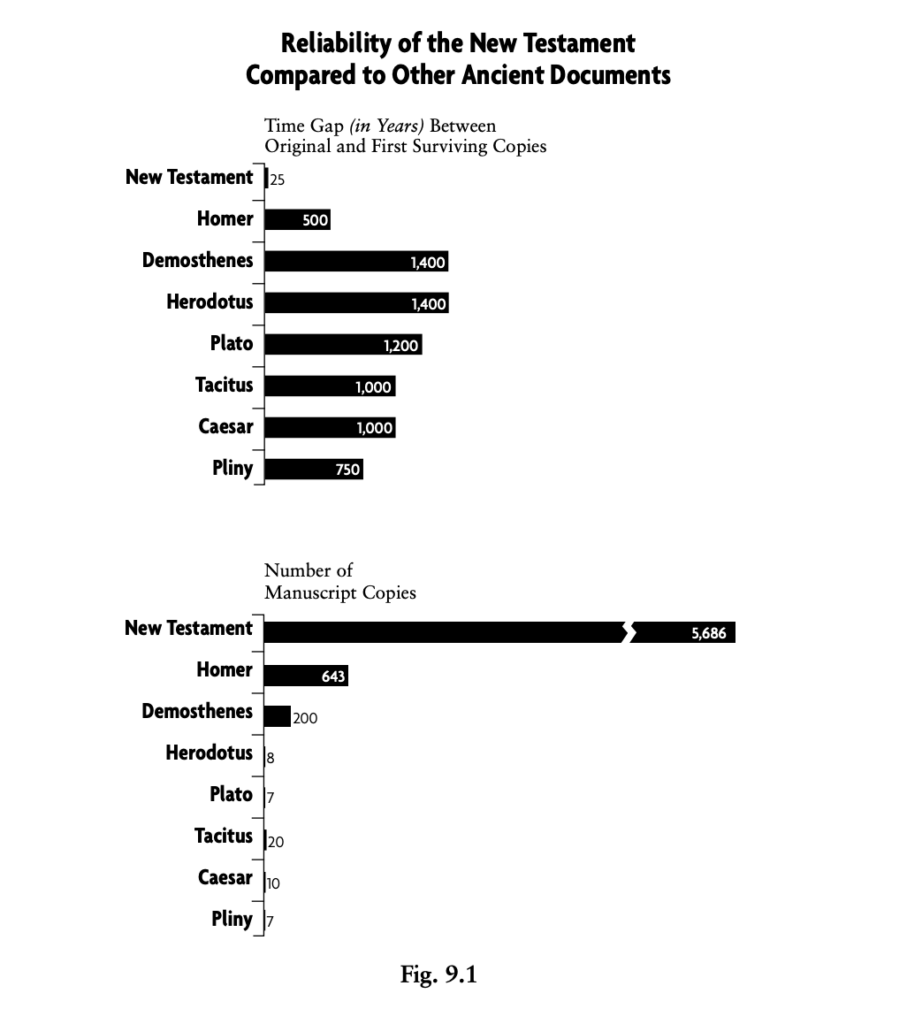
Turek and Geisler go onto say “Some scholars believe these fragments are parts of six New Testament books including Mark, Acts, Romans, 1 Timothy, 2 Peter, and James. While other scholars resist this conclusion (perhaps because its admission would undermine their liberal leanings that the New Testament was written later), they have not found any other non–New Testament texts that these fragments could be.” [4]ibid. page 226
However, even if those six fragments aren’t the earliest, then that means that the true earliest manuscript is the John Rylands fragment. Depending on whether the gospels were penned from the 40s to the 60s (the early conservative date) or the 70s to the 90s (according to the late liberal date), this means that the earliest fragment of John’s gospel ranges from about 10-30 years after the composition of John’s gospel! “But, you may say”, that’s just a fragment. What about entire books of The New Testament? According to the late New Testament scholar Bruce Metzger, “We have what are called uncial manuscripts, which are written in all-capital Greek letters, … Today we have 306 of these, several dating back as early as the third century. The most important are Codex Sinaiticus, which is the only complete New Testament in uncial letters, and Codex Vaticanus, which is not quite complete. Both date to about AD 350.” [5]Strobel, Lee; Strobel, Lee. Case for Christ Movie Edition: Solving the Biggest Mystery of All Time (Case for … Series) . Zondervan. Kindle Edition.
So, we have thousands of manuscripts from multiple languages, multiple geographic locations, spanning from the 300s to the present with regards to entire books of The New Testament, and possibly going all the way back to the dawn of the second century with regards to fragments. This is, as Bruce Metzger said in his interview with Lee Strobel in “The Case For Christ”, a wealth of evidence! [6]Ibid. Kindle Locations 1397-7114
The fact that the manuscripts of The New Testament are very large in number, very early in date, and are supported, help textual critics reconstruct the content of the original New Testament documents with ease. The process consists of comparing and contrasting the huge number of manuscripts. So, you have people like Daniel Wallace and others who compare all the different manuscripts we have – both fragments and complete copies – from the earliest surviving fragments and total copies to the present, and this allows these scholars to see “Hey, the text survived without any major changes!” Now, this isn’t to say that every manuscript we have is completely identical. They’re not. However, what differences are in the manuscripts don’t affect scholars’ confidence in what the original said. And it is precisely because of the large quantity of manuscripts and the earliness of them that allows this confidence. How does this work?
How Reconstructing The Text Works
Cold Case homicide detective and Christian Apologist J. Warner Wallace gives a great illustration of how this works in his book “Cold Case Christianity”. Wallace writes;
“Imagine that you are my patrol partner one afternoon as we are working beat 514C. We get a call from dispatch on our MDT (the mobile computer in our police unit) that summons us to a robbery taking place at a local mini-mart. The dispatch operator sends us the call but accidentally types the wrong street name and misspells the weapon. We recognize that there is no street by this name in our city, but we know that a very similar street (with the same hundred block) does exist in our beat. As we head in that direction, we notify dispatch and receive a new communiqué with the corrected street name. In this second dispatch, however, the operator makes an additional error and misspells the word Markey. We again notify the dispatcher and receive yet another message, but once again, there is a misspelling. The dispatcher makes two more repeated efforts to correct the misspelling but, in the pressure of the moment (remember a robbery is occurring), is never quite able to do it without some form of error:
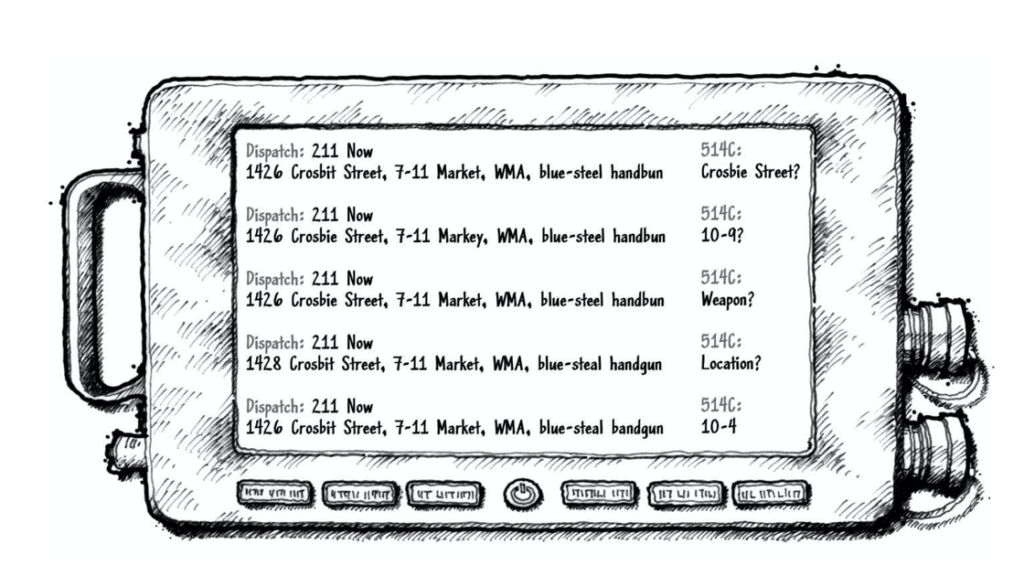
Now let me ask you a question: With the robbery in progress and time of the essence, should we stop at the curb and wait for dispatch to type the call correctly, or do we have enough information, given the growing number of duplicated lines the dispatcher is sending, to proceed to the call? The more the dispatcher repeats the call, even with a number of typos and errors, the more confidence we have that we know what kind of call we are handling and where the crime is occurring. The more copies we possess, the more we can compare them to determine the dispatcher’s original meaning, and the more confidence we can have in our conclusion.” [7]J. Warner Wallace. Cold-Case Christianity: A Homicide Detective Investigates the Claims of the Gospels (Kindle Locations 3987-4000). David C. Cook. Kindle Edition.
The results of such manuscript comparison is that we can know with 99.99% of what the original New Testament text said.
But What About The Differences?
Some people may wonder about the differences in the extant manuscripts. How significant are these differences? How many are there? And how did they get there?
In his bestselling book, Misquoting Jesus, Ehrman writes,
“What good is it to say that the autographs (i.e., the originals) were inspired? We don’t have the originals! We have only error-ridden copies, and the vast majority of these are centuries removed from the originals and different from them, evidently, in thousands of ways…. There are more variations among our manuscripts than there are words in the New Testament.” [8]Bart Ehrman, “Misquoting Jesus: The Story Behind Who Changed The Bible and Why”, HarperOne 2009
This sounds damning! More variants than words!? How then, can it be that most textual critics say we can have 99.9% certainty of what the original documents said? As textual critic Daniel Wallace explains; “Spelling and nonsense readings are the vast majority, accounting for at least 75% of all variants. The most common variant is what’s called a movable nu—that’s an ‘n’ at the end of one word before another word that starts with a vowel. We see the same principle in English with the indefinite article: ‘a book,’ ‘an apple.’ These spelling differences are easy for scholars to detect. They really affect nothing. The second largest group, changes that can’t be translated and synonyms, also do not affect the meaning of the text. Frequently, the word order in the Greek text is changed from manuscript to manuscript. Yet the word order in Greek is very flexible. For the most part, the only difference is one of emphasis, not meaning.” [9]“An Interview with Daniel B. Wallace on the New Testament Manuscripts”, Justin Taylor, | MARCH 22, 2012, https://www.thegospelcoalition … Continue reading
A third difference that accounts for variants are spelling errors and slips of the pen. Dr. William Lane Craig said this in his Defenders class; “Of the 138,000 words contained in the New Testament, I believe it is only around 1,400 words that are still uncertain. We are not exactly sure what the text read in those cases. None of these are significant. No doctrine hangs upon one of these textual variants. For example, one would be in 1 John when he says, ‘We write this that our joy may be full.’ Other manuscripts say, ‘We write this that your joy may be full.’ The difference is the personal pronoun ‘our’ or ‘your.’ We are not sure what the original text said in that case. So if you have a Greek New Testament, at the bottom of the page it will have what is called an apparatus where it will list the various textual variants and the degree of confidence that we have in the text that we have reconstructed.” [10]William Lane Craig, Defenders 3, Doctrine of Revelation (Part 4): The Inspiration of Scripture, December 03, 2014, — … Continue reading
As you can see, the vast, vast majority of variants are inconsequential. Another important thing to keep in mind is that these thousands of variants aren’t contained to any one particular manuscript. They’re spread out across multiple manuscripts. The way variants are counted is if there’s one manuscript with one spelling error, difference in wording, etc. that counts as one variant. If you have three manuscripts and one manuscript has a spelling error, one has an entirely invented verse, and one has different pronouns used, then this amounts to three variants. So, don’t let skeptics like Bart Ehrman who try to hype up the huge number of variants cause you to doubt what The New Testament says. These skeptics are distorting the facts and making it sound as though all the variants (most of which, again, are inconsequential) are in one codex of The New Testament. That’s just not the case. Again, if you have one variant in one manuscript, and you have 4,000 manuscripts each containing one variant, that adds up to 4,000 variants.
In fact, Bart Ehrman himself admits “Essential Christian beliefs are not affected by textual variants in the manuscript tradition of the New Testament.” [11]Misquoting Jesus, 2005, p. 252, cf. “The Elusive Bart Ehrman Quote” – https://christianapologetics.org/biblical-items/the-elusive-bart-ehrman-quote/
Major Variants
Now, there are some really big variants which are more substantial than changes in word ordering, spelling errors, slips of the pen, changes in word order, etc. In fact, there are entire gospel episodes and verses invented by scribes out of whole cloth! Perhaps the most famous of these are the episode in which Jesus deals with an adulterous woman in John 8:1-11 and what used to be considered the silver bullet proof text for the doctrine of the Trinity in 1 John 5:7-8.
In the former, we read; “But Jesus went to the Mount of Olives. And early in the morning He came again into the temple area, and all the people were coming to Him; and He sat down and began teaching them. Now the scribes and the Pharisees brought a woman caught in the act of adultery, and after placing her in the center of the courtyard, they said to Him, ‘Teacher, this woman has been caught in the very act of committing adultery. Now in the Law, Moses commanded us to stone such women; what then do You say?’ Now they were saying this to test Him, so that they might have grounds for accusing Him. But Jesus stooped down and with His finger wrote on the ground. When they persisted in asking Him, He straightened up and said to them, ‘He who is without sin among you, let him be the first to throw a stone at her.‘ And again He stooped down and wrote on the ground. Now when they heard this, they began leaving, one by one, beginning with the older ones, and He was left alone, and the woman where she was, in the center of the courtyard. And straightening up, Jesus said to her, ‘Woman, where are they? Did no one condemn you?‘ She said, ‘No one, Lord.‘ And Jesus said, ‘I do not condemn you, either. Go. From now on do not sin any longer.‘”
Now, this passage is entirely in keeping with the character of Jesus. We can plausibly see Jesus doing something like this. He was known to be loving and compassionate towards sinners (e.g Matthew 9:10-17, Mark 2:15-22, Luke 5:29-39, Mark 10:21, Luke 7:36-50, John 3:16). He was also known to wiggle his way out of the most tight logical traps his opponents tried to trap him in (e.g Matthew 22:43-46, Matthew 22:15-22). And he also was known to follow the heart of the law over the letter (e.g Mark 2:23-28, Matthew 12:1-8). On this basis, some scholars have argued that this event and dialogue actually occurred. However, what isn’t disputed is that this was not in the original copy of the gospel of John. Perhaps it really happened and a later scribe felt that this episode was too important to leave out, so in making his copy of the gospel of John, he added it in. Or perhaps someone got really creative and made up the event and put words into the mouths of Jesus, the pharisees, and the adulterous woman. No matter how or why this made it’s way into some of the manuscripts, the fact remains that John the son of Zebedee did not write these words down. They came later. This isn’t some secret that the church and Bible scholars are keeping from the public. Pull out any modern translation of The Bible that you have and go to this section. Some translations have omitted this passage completely, some have included it but have it inside of brackets. The latter not only bracket the passage, but have a footnote at the bottom explaining that the best and earliest manuscripts don’t include this passage. In fact, my brown leather ESV says it right in the main text after John 7:52.
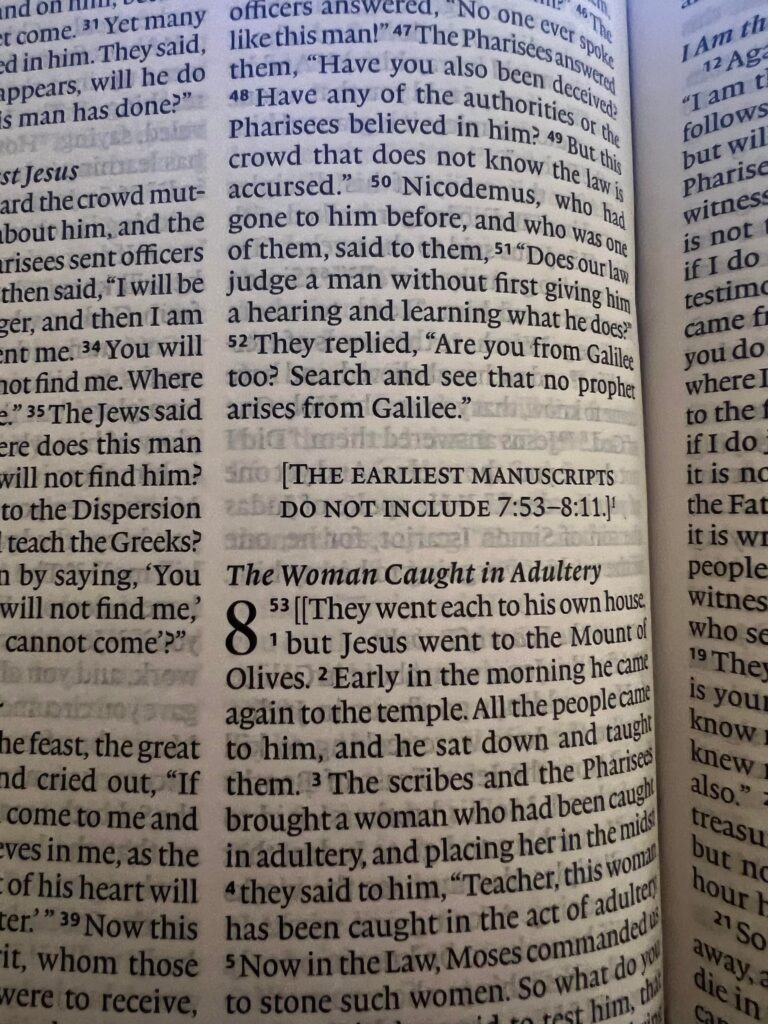
1 John 5:7-8 used to be a favorite proof text of English speaking Christians before more modern translations like the NIV, ESV, and CSB were produced. Why? Because in The King James Version, it reads “For there are three that bear record in heaven, the Father, the Word, and the Holy Ghost: and these three are one.” The three are one. The Father is a term obviously referring to God, and cross referencing this with John 1 in the gospel of John, we know that Jesus is called “The Word” (Logos in Greek). And The Holy Ghost is referenced all over The New Testament. This verse says that these three individuals are one. Three persons, one divine essence! That’s the Trinity and it’s stated in one single verse! That’s great, isn’t it!? Well, it would be if this is what John initially wrote in his epistle. The best manuscript data we have shows that this verse was not originally in 1 John. It was added in later by a scribe.
I want to stress that this does not provide any problems for defending the doctrine of The Trinity. I’ve written a blog post titled “Does The Bible Teach That God Is A Trinity?” and I’ve also done a Cerebral Faith Live episode on my YouTube channel also called “Does The Bible Teach That God Is A Trinity?” The web show presentation goes into more detail than the blog post, but in both, I defend the doctrine of The Trinity by means of inferring it from several different teachings of scripture. The Bible teaches that (1) There is only one God, (2) The Father is God, (3) Jesus is God, (4) The Holy Spirit is God, and (5) The Father, Son, and Holy Spirit are distinct persons. All 5 of these statements are taught in various portions of The Bible and the doctrine of The Trinity is the only view that makes sense of all 5 of them.
Another major variant is the so-called “Longer Ending Of Mark”. The final chapter of Mark’s gospel is Mark 16. Mark ends his gospel with the women running away from the tomb to tell the disciples that Jesus has risen, and it just ends there! No postmortem appearances are narrated except in a longer ending found in some manuscripts that made its way into the King James Version and that, again, modern translations either omit entirely or leave bracketed with a disclaimer. I for one am glad that Mark’s longer ending isn’t canon, for this part of The Bible contains the sole proof text that snake handlers use to justify their practice.
“When Jesus rose early on the first day of the week, he appeared first to Mary Magdalene, out of whom he had driven seven demons. She went and told those who had been with him and who were mourning and weeping. When they heard that Jesus was alive and that she had seen him, they did not believe it. Afterward Jesus appeared in a different form to two of them while they were walking in the country. These returned and reported it to the rest; but they did not believe them either. Later Jesus appeared to the Eleven as they were eating; he rebuked them for their lack of faith and their stubborn refusal to believe those who had seen him after he had risen. He said to them, ‘Go into all the world and preach the gospel to all creation. Whoever believes and is baptized will be saved, but whoever does not believe will be condemned. And these signs will accompany those who believe: In my name they will drive out demons; they will speak in new tongues; they will pick up snakes with their hands; and when they drink deadly poison, it will not hurt them at all; they will place their hands on sick people, and they will get well.‘”‘ After the Lord Jesus had spoken to them, he was taken up into heaven and he sat at the right hand of God. Then the disciples went out and preached everywhere, and the Lord worked with them and confirmed his word by the signs that accompanied it.“
Verse 18 is the verse that snake handlers use. Of course, one could argue that Jesus here is simply predicting some of the miraculous feats that His apostles will do, not that He is prescribing normative practices for all Christians in all ages [12]Scholars have located touchpoints between these predictions and some of the things the apostles did. For example, all the apostles spoke in tongues in Acts 2. Paul was bitten by a snake and did not … Continue reading However, since the earliest and best manuscripts don’t contain these verses, why not just dismiss the passage altogether?
Now, at this point, someone may be concerned that entire verses and stories could be inserted in the text. However, one should remind oneself how we know these passages don’t belong in our Bibles. We know they don’t belong in The New Testament because textual critics have thousands and thousands of manuscripts in a variety of different languages, dating from as early as the 300s to the present in the case of entire books, and dating as far back as the dawn of the second century with regards to fragments. And by comparing the wording of all of these different manuscripts, scholars can and have reconstructed the text to 99.99% accuracy. All this means is that we know what’s supposed to be in The New Testament, so those verses and passages that don’t stick out like a sore thumb! If we weren’t certain about original words of The New Testament, these blatant late additions would just blend in with the rest of the text. However, they don’t blend in with the rest of the text. They stick out like a sore thumb!
Conclusion
We know from the aforementioned evidence that scholars can and have reconstructed the original New Testament text with 99.99% of certainty. That small percentage of uncertainty doesn’t affect any major Christian doctrines. Moreover, when you compare The New Testament with other ancient works like Homer’s Illiad, the writings of Tacitus, or the writings of Pliny, The New Testament supercedes them all in terms of both the number of manuscripts and the short gap in time between when the originals were likely written and the earliest extant copies. If one insists that the manuscript evidence is not good enough for us to have confidence in what the original New Testament said, in order to be consistent, they would have to throw out all of these other sources as well. Yet, no one doubts that we can know what Tacitus or Pliny wrote. No one doubts that we know what the original Illiad said. And yet, these latter documents have a piddly amount of manuscript evidence in their favor when compared to The New Testament.
Yes, we can know what the original New Testament documents said. However, all this goes to show is that we have a near-perfect copy of the gospels (and epistles), not that what they said is actually true. We could have a near-perfect copy of the truth or we could have a near-perfect copy of a lie. In order to decide which one is the case, we’ll have to examine more evidence. In the next chapter, I will examine external and internal evidence for the traditional authorship of the gospels. For if the men whose names are ascribed to the gospels are the ones who actually wrote them, then that means the gospels are eyewitness sources. It is to this subject that we now turn.
References
| ↑1 | I know that ascribing these books to these men is hotly contested. Be patient with me. I will give arguments and evidence for the traditional authorship of the gospels later on in this series |
|---|---|
| ↑2 | Edward John Kenney, “Textual Criticism”, https://www.britannica.com/topic/textual-criticism |
| ↑3 | Frank Turek, Norman Geisler, “I Don’t Have Enough Faith To Be An Atheist”, Crossway, March 1, 2004, page 225 |
| ↑4 | ibid. page 226 |
| ↑5 | Strobel, Lee; Strobel, Lee. Case for Christ Movie Edition: Solving the Biggest Mystery of All Time (Case for … Series) . Zondervan. Kindle Edition. |
| ↑6 | Ibid. Kindle Locations 1397-7114 |
| ↑7 | J. Warner Wallace. Cold-Case Christianity: A Homicide Detective Investigates the Claims of the Gospels (Kindle Locations 3987-4000). David C. Cook. Kindle Edition. |
| ↑8 | Bart Ehrman, “Misquoting Jesus: The Story Behind Who Changed The Bible and Why”, HarperOne 2009 |
| ↑9 | “An Interview with Daniel B. Wallace on the New Testament Manuscripts”, Justin Taylor, | MARCH 22, 2012, https://www.thegospelcoalition org/blogs/justin-taylor/an-interview-with-daniel-b-wallace-on-the-new-testament-manuscripts/ |
| ↑10 | William Lane Craig, Defenders 3, Doctrine of Revelation (Part 4): The Inspiration of Scripture, December 03, 2014, — https://www.reasonablefaith.org/podcasts/defenders-podcast-series-3/s3-doctrine-of-revelation/doctrine-of-revelation-part-4#_ftn4 |
| ↑11 | Misquoting Jesus, 2005, p. 252, cf. “The Elusive Bart Ehrman Quote” – https://christianapologetics.org/biblical-items/the-elusive-bart-ehrman-quote/ |
| ↑12 | Scholars have located touchpoints between these predictions and some of the things the apostles did. For example, all the apostles spoke in tongues in Acts 2. Paul was bitten by a snake and did not die in Acts 28. And extra biblical sources say that the apostle John was given poison by the Romans. However, John did not die from the poison, so they gave up on poisoning him and exhiled him to the island of Patmos. |
Discover more from Cerebral Faith
Subscribe to get the latest posts sent to your email.

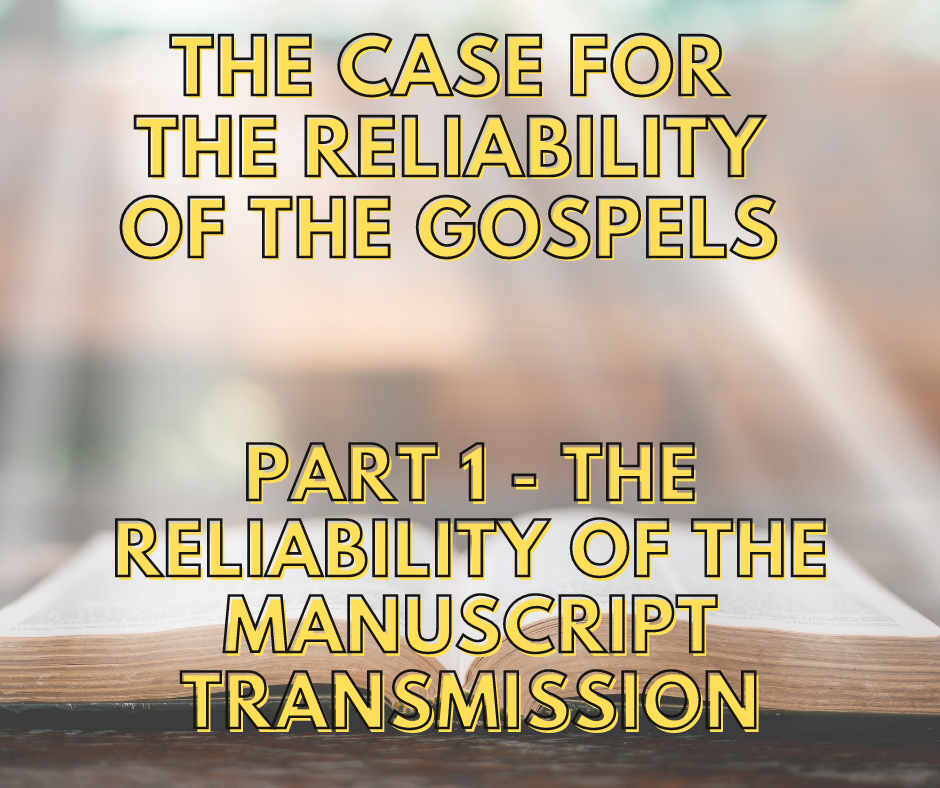
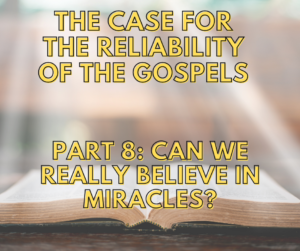

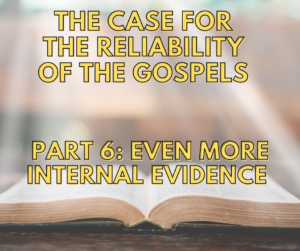
Hi Evan, I just wanted to let you know that I am sincerely thankful and appreciative that you are doing this case study and especially grateful for the thoroughness you employ within the case study. Once the series is completed, I shall be showcasing the series in a post on my blog and including the case study as a Christian Apologetic Resource on my applicable web page. God’s continued blessings on you and yours!
Thank you for your praise and encouraging words. This comment in going in my Encouragement Folder in my Google Drive. 😀
Hi Evan! Amazing work, as always. I wonder, though, if your case could be even stronger if you introduced two additional pieces of date. 1) The comparison between a free and a controlled transmission of the text. I mention this because even if you had tons of second or third century manuscripts, you could argue that someone standardized a version of the New Testament and erased all the evidence from prior decades. Something like that happened with the Quran. 2) The quotes of church fathers. We could reconstruct almost every piece of the New Testament even without any manuscript, just with church father’s writings.
I’m willing to engage that idea if it comes up, but it’s such a fringe notion that I didn’t even think of it when writing this article. Recently I saw a TikTok excerpt of a preacher talking about what conspirators would have to do if they wanted to radically change the text. And it’s such a wildly implausible scenario . Have a look —> https://www.tiktok.com/t/ZTRErxMXq/
.
Moreover, if one wants to make that argument, then one ought to be consistent and reject the writings of Josephus, Tacitus, Pliny, etc. These survive on a far smaller number of manuscripts dating even longer after the originals were written down. Why subject The New Testament documents to this level of skepticism, but not other ancient writings? It’s a double standard.
If someone were to change The New Testament documents before the earliest surviving copy, they basically would have had to run all over the ancient world to do it. Because as scholars of all stripes will tell you, the New Testament documents were copied and transmitted across the ancient world at an extremely rapid pace. That’s part of the reason we have so many surviving copies. These were considered holy scripture, and, ergo, were treated with more importance than the writings of secular authors. This works to our advantage because that makes the chances of early overzealous Christians radically changing things. Indeed, when people did try to change or add things, due to the manuscript evidence, we’re able to know when they did it. The later additions stick out like sore thumbs. We just know “That’s not supposed to be in there.”